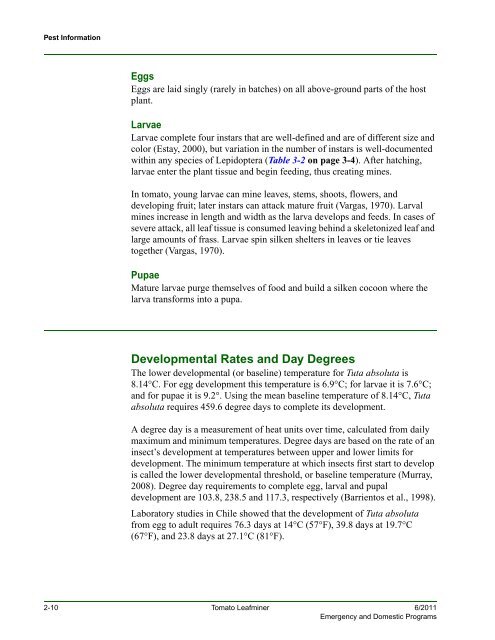1 - Phytosanitary Resources
1 - Phytosanitary Resources
1 - Phytosanitary Resources
You also want an ePaper? Increase the reach of your titles
YUMPU automatically turns print PDFs into web optimized ePapers that Google loves.
Pest Information<br />
Eggs<br />
Eggs are laid singly (rarely in batches) on all above-ground parts of the host<br />
plant.<br />
Larvae<br />
Larvae complete four instars that are well-defined and are of different size and<br />
color (Estay, 2000), but variation in the number of instars is well-documented<br />
within any species of Lepidoptera (Table 3-2 on page 3-4). After hatching,<br />
larvae enter the plant tissue and begin feeding, thus creating mines.<br />
In tomato, young larvae can mine leaves, stems, shoots, flowers, and<br />
developing fruit; later instars can attack mature fruit (Vargas, 1970). Larval<br />
mines increase in length and width as the larva develops and feeds. In cases of<br />
severe attack, all leaf tissue is consumed leaving behind a skeletonized leaf and<br />
large amounts of frass. Larvae spin silken shelters in leaves or tie leaves<br />
together (Vargas, 1970).<br />
Pupae<br />
Mature larvae purge themselves of food and build a silken cocoon where the<br />
larva transforms into a pupa.<br />
Developmental Rates and Day Degrees<br />
The lower developmental (or baseline) temperature for Tuta absoluta is<br />
8.14°C. For egg development this temperature is 6.9°C; for larvae it is 7.6°C;<br />
and for pupae it is 9.2°. Using the mean baseline temperature of 8.14°C, Tuta<br />
absoluta requires 459.6 degree days to complete its development.<br />
A degree day is a measurement of heat units over time, calculated from daily<br />
maximum and minimum temperatures. Degree days are based on the rate of an<br />
insect’s development at temperatures between upper and lower limits for<br />
development. The minimum temperature at which insects first start to develop<br />
is called the lower developmental threshold, or baseline temperature (Murray,<br />
2008). Degree day requirements to complete egg, larval and pupal<br />
development are 103.8, 238.5 and 117.3, respectively (Barrientos et al., 1998).<br />
Laboratory studies in Chile showed that the development of Tuta absoluta<br />
from egg to adult requires 76.3 days at 14°C (57°F), 39.8 days at 19.7°C<br />
(67°F), and 23.8 days at 27.1°C (81°F).<br />
2-10 Tomato Leafminer 6/2011<br />
Emergency and Domestic Programs













